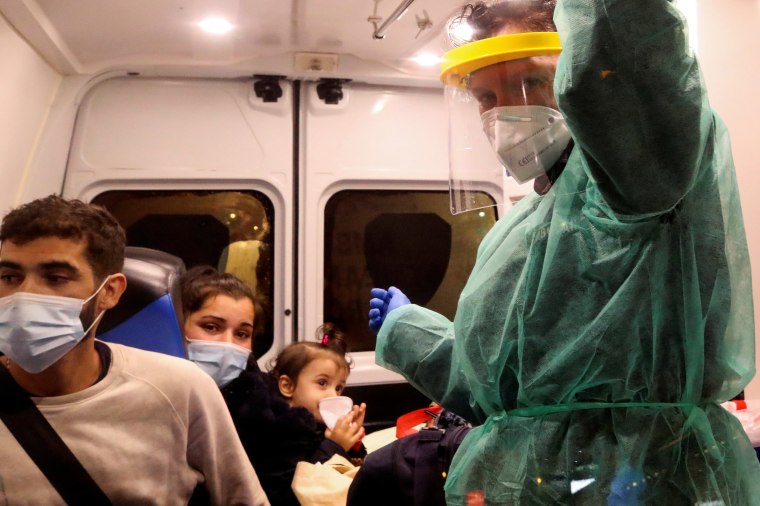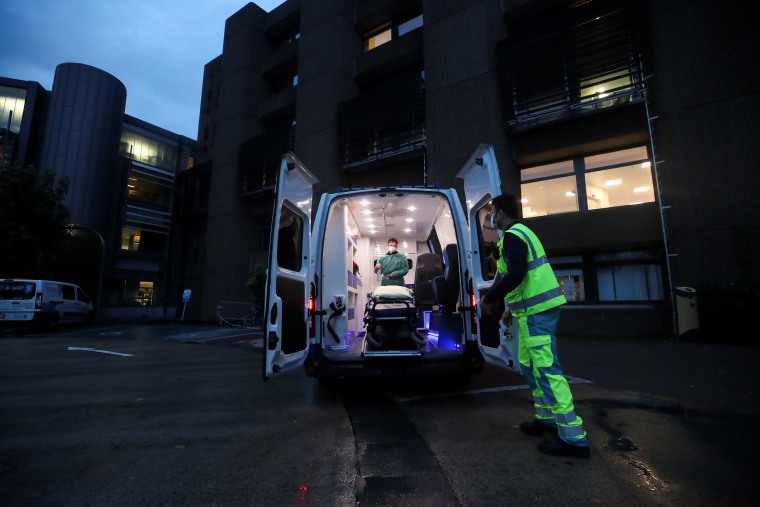BRUSSELS — Covid-19 is ravaging tiny Belgium, the home to NATO and the headquarters of the European Union.
With a rate of 1,735 cases per 100,000 inhabitants in 14 days, it has the highest rate of coronavirus infections in Europe. Many hospitals are overwhelmed, with some doctors being told to show up to work even if they have been diagnosed with the virus.
When the government announced strict new lockdown measures Friday, the total number of deaths stood at 11,308, with 400,000 total cases — giving it one of the continent’s highest mortality rates. Only much-larger France, Spain, the U.K. and Italy have had more people die from the virus, according to the European Centre for Disease Prevention and Control.
NBC News looks at what the self-proclaimed capital of Europe got so wrong.
Hospitals at risk of collapse
On Oct. 24, Rudi Vervoort, the head of the country’s capital region, warned of “runaway” infection rates.
“A major issue is the risk of the collapse of the hospital system of our country,” he said.
While Belgium is relatively well-served with intensive care unit beds, with 2,000 available in a country of less than 12 million, more than half of those spaces were occupied by Covid-19 patients by Friday, according to the government agency Sciensano. In addition, the number of patients in ICU is not spread evenly across the country, and hospitals are already being overrun in some parts of the country.
In Liège, for example, the situation is “catastrophic,” said Philippe Devos, president of the Belgian Association of Medical Unions and an intensive care doctor at the CHC MontLégia hospital in the city.
On Oct. 25, he told national broadcaster RTBF that between one-fifth and one-quarter of medical staff were sick or quarantining, but he added that “positive cases would be asked to go back to work if they are asymptomatic.”

For their part, hospital staff called on the federal government for emergency reinforcements. They protested outside the clinic on Thursday.
“The distress is palpable — workers can no longer take it. Every day, we are contacted by colleagues at the end of their rope. Where are the promised reinforcements?” said the workers union, CNE, in a statement.
Internal strife
Belgium is mired in administrative and political crises — all of which have impacted its response to the pandemic.
Until the beginning of October, the country had not been able to form a federal government for 592 days — around 19 months. Longstanding linguistic and cultural divisions — northern, Dutch-speaking Flanders; southern, French-speaking Wallonia; and a sizable German-speaking area in the east — fuel these issues.
During the first wave of Covid-19 in the spring, it was the wealthier, northern region of Flanders that bore the brunt of the pandemic. Many blamed the surge on tourists returning from skiing in the Italian Alps. But as the pandemic spread across the country, a caretaker government implemented a strict lockdown that saw the disease reduced along similar lines seen elsewhere in Europe.
Download the NBC News app for the latest news on the coronavirus
Regional differences and divisions have a tangible impact on the ground, according to Marc Botenga, a Belgian member of the European Parliament. But even more than the differences between the regions, organizational problems have dogged the country’s approach to the crisis.
At first, for example, nine ministers were tasked with running the health system, he said.
“Having nine ministers in charge means no one is really in charge or no one is really responsible,” Botenga said.
“Divisions have been a problem from the beginning,” he added. “It makes no sense because the virus does not stop at the linguistic border.”
So while the pandemic appeared under control to the outside world during the summer, this was actually a time marred by tensions between regions. In August, mayors of seaside towns threatened to close them to “outsiders” aftera brawl erupted on a Belgian beach. Some members of the right-wing Flemish separatist party Nieuw-Vlaamse Alliantie — the New Flemish Alliance — even called for trains to stop traveling to the coast from other parts of the country.
By October, Covid-19 cases were rising everywhere.
Conflicting guidance, poor rollout
When national measures were announced on Oct. 16, they included a midnight to 5 a.m. curfew throughout Belgium, and the closure of the bar, restaurants and hotel sectors. Brussels and Wallonia went further, imposing a new 10 p.m. to 6 a.m. curfew and shutting gyms, museums and other cultural centers.
But Flemish Minister-President Jan Jambon resisted calls for tougher measures in Flanders, saying he wouldn’t “hose down his house in case it might catch fire next week.”
Virologist Marc Van Ranst described Jambon’s position as “incomprehensible.”
On Oct. 28, Jambon said rules would be tightened and Flanders closed gyms and cultural centers. But it maintained different curfew hours.

This patchwork of measures breeds confusion, said Anthony Zacharzewski, president of the Democractic Society, a Brussels-based nongovernmental organization.
”Single simple messages always work best,” he said. “Belgium’s different regions and communities have set different rules at different times and haven’t coordinated main messages, to such an extent that even the closest follower of the news isn’t sure what rules are in force where.”
Another major failure has been the lack of an effective track-and-trace system, according to Pieter Cleppe, research fellow at think tank Property Rights Alliance.
“Belgium's federal government did a good job expanding the country’s testing capacity, even if labs could no longer follow a few weeks ago, which some have blamed the government for,” he said. “In any case, testing is not of much use when it isn't followed up by contact tracing.”
What’s next?
On Friday, Belgium unveiled tighter restrictions on social contacts and a six-week closure of businesses like hairdressers and shops that provide nonessential services. It also extended a November school break by a week.
Belgium's numbers may be the worst on the continent, but across Europe fresh lockdowns were also announced over the last several days. In Germany, Chancellor Angela Merkel addressed parliament last Thursday warning of a long hard winter, implementing a partial lockdown through November 30. In France, where deaths from the virus are climbing to levels not seen since spring,President Emmanuel Macron closed non essential business, cafes and bars, but kept schools open and Austrian Chancellor Sebastian Kurz announced the closure of restaurants, theaters, and museums and imposed a nationwide evening curfew.
Belgian Prime Minister Alexander de Croo said the country of 11 million people otherwise faced a breakdown of its health system if they did not implement the measures, which fell just short of a full lockdown.
"We are moving in the direction of reinforced confinement with a single objective: to prevent health care from creaking under pressure that is already immense today," de Croo told a news conference.
"These are the last-chance measures."
Reuters contributed to this report.
